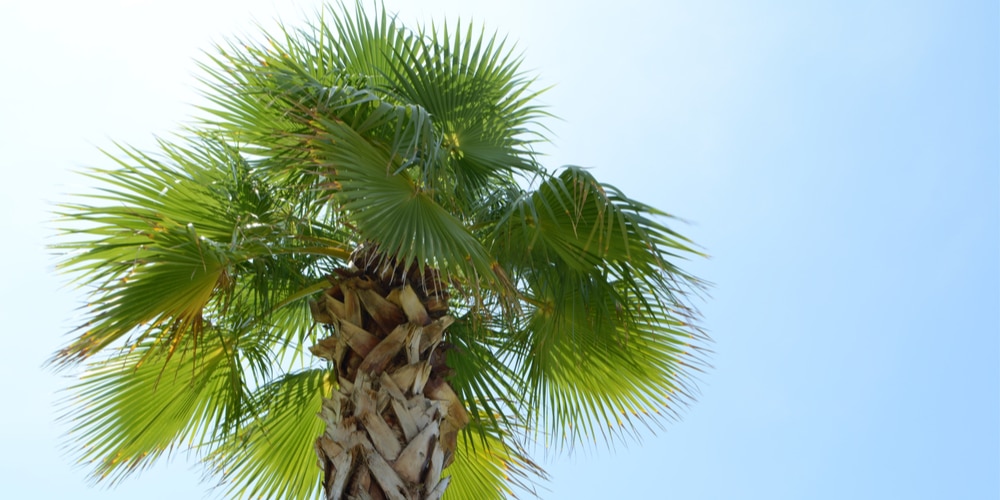Sylvester Palm, Cycas revoluta , is a cycad native to Japan and South Korea. The plant had been introduced into cultivation in Europe by 1800, and was first brought to North America in 1854. It has since become popular as an ornamental plant and houseplant, valued for its tolerance of indoor temperatures, low light conditions, and infrequent watering.
General Appearance of the Sylvester Palm:
Sylvester Palm is a slow-growing evergreen plant that only grows two to three feet tall on average, but can reach up to six feet in height in its native environment if left undisturbed.
Trunk and Seeds
The trunk is very low and often subterranean, leading to its common name of the “Stump Palm.” The plant is basically composed of one or more large leaves that are divided into leaflets on either side of a central stem.
Like many other members of its family, it produces cones with densely clustered seeds at the top of the trunk, which can grow up to four to six inches in length.
The main stem terminates in a crown of showy yellow flowers in the summer months. Once pollinated, these flowering heads produce fruit containing seeds that are coveted for their starch content and used as food by Native Americans, Hawaiians, Polynesians, and Filipinos.
Leaves
The leaves are large, dark green, shiny, and deeply divided into glossy leaflets. Each leaf may be up to two feet long by one foot wide, but only about half of this length is actually occupied by the leaflets. The petioles or leaf stalks are up to eight inches in length and form an open cone at the base of the plant.
Cones
The cones are large, green, and fleshy in appearance. They are composed of sporophylls or leaf-like scales on the stalk surrounding a central axis on which numerous small pollen-producing male flowers are found. As the cone matures, it turns brown and woody in texture
How to Care for the Sylvester Palm
Here’s everything you need to know about growing and caring for a thriving Sylvester Palm:
Light
Sylvester Palm is a sun-loving plant and thrives in full, bright light. If it cannot be moved outdoors for the summer months, provide at least a few hours of direct sunlight. Although they can grow indoors, these plants do not create their own food through photosynthesis and need to be fed regularly with an all-purpose fertilizer.
Watering
Sylvester Palm should be watered thoroughly until water runs through the soil and then allowed to dry slightly between watering. It does not require constant moisture, but rather should only be kept moist during its growing season (spring to summer). During the winter months, it is preferable to allow the plant’s soil to slightly dry out between watering.
Humidity
Although they are native to areas with very humid air, Sylvester Palm plants will grow well in environments where the humidity is relatively low. Indoor plants usually only need occasional misting of the foliage. These plants do not require high humidity during their active growth phase, but the soil should be kept slightly moist at all times.
Temperature
Sylvester Palm plants are very hardy and will tolerate a broad range of temperatures as long as they have adequate moisture. In fact, their native habitat lies within USDA zone 9a to 11 so it can be grown outdoors in most areas of the southern United States or kept indoors year-round without issue.
Fertilizing and Soil
Although it is not necessary to feed a Sylvester Palm plant during its dormant period (late autumn and winter), regular feeding with an all-purpose fertilizer during the growing season will help keep it healthy and full. It can be placed in a container that drains well so excess water can freely leave the pot. The soil mix should be well-drained but still retain moisture, so the addition of perlite or sand can help improve drainage.
Pruning
Although Sylvester Palm plants are slow-growing, they will eventually need to be pruned back if they become top-heavy. Topping off this plant is rarely recommended since it may result in a weakened and unattractive appearance.
Instead, smaller plants can be pruned by carefully snipping off the top with sharp shears to encourage branching. If an older plant becomes too large for its space, it can safely be cut back by about one-third during late winter or early spring to rejuvenate it and encourage new growth.
Cleaning
Sylvester Palm plants are easily dusty or dirty and should be gently wiped down with a damp cloth to remove any accumulated soil particles. They do not require frequent cleaning, however, since their large leaves usually collect dust on the undersides.
Pest Control
Sylvester Palm plants are rarely bothered by pests as they come from a very humid tropical climate. Occasional pests may include mealybugs, mites, or scale insects, which can be controlled by handpicking or with the use of insecticidal sprays.
Repotting
Sylvester Palm plants require repotting every several years to replace old soil and provide fresh nutrients and added space for root growth. The plant can be carefully lifted from its container and placed into a larger one with fresh potting soil around the roots.
Propagation
Sylvester Palm plants cannot be propagated by seeds since they require pollination to set fruit. They can, however, be easily propagated by stem cuttings taken during the growing season. Cuttings should be carefully removed from healthy stems at a node (point where leaf meets stem) and carefully placed in moistened perlite. They will produce roots within 2 to 3 months and can then be transplanted into small containers with damp soil.
Where to Buy
Sylvester Palm plants are rarely found within the home and garden centers. The best source for these plants is online specialty retailers and plant nurseries. Be sure to inquire about size and age when buying a Sylvester Palm plant since it can become top-heavy as it grows taller.
How to Maintain
Generally, Sylvester Palm plants do not require much maintenance; however, they are occasionally bothered by pests or may need to be repotted. Be sure to consult the tips above for more information on caring for this plant.
Sylvester Palm plants can be placed outdoors during the summer months or kept indoors year-round if it is given enough light and water attention. They are slow-growing plants but will grow to be at least 10 feet tall as they mature. Therefore, it is best to properly prune and repot them before they become top-heavy or place them inside if outdoor placement will not be possible.
Conclusion
Although Sylvester Palm plants are slow-growing, they make attractive additions to the garden or home when provided with ample water, light, and nutrients. The best way to care for these plants is by providing them with plenty of direct sunlight, watering them well during the growing season, and pruning back if needed.


